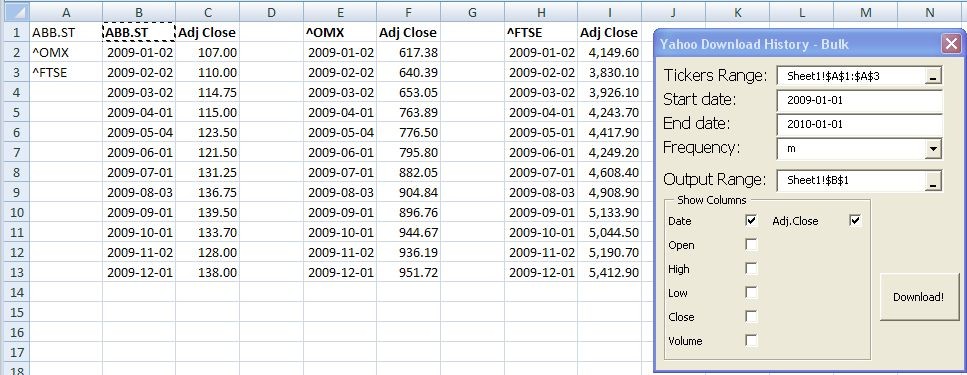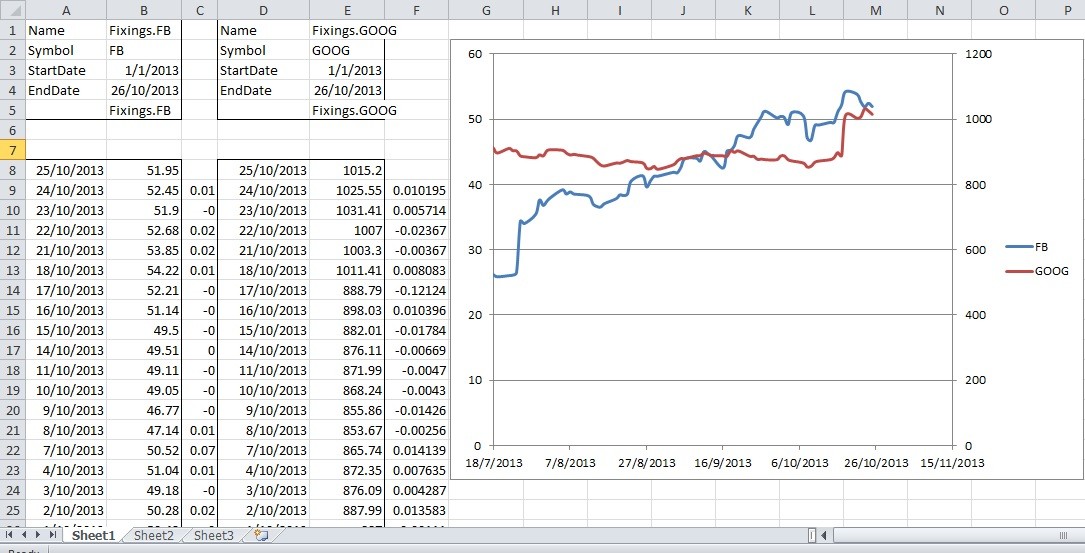Finance Addin for Excel
Post on: 17 Май, 2015 No Comment

Copulas and simulation
Copulas and simulation: Copulas provide a powerful and flexible model for simulating financial returns for multiple assets where individual asset return distributions are specified independently of the dependen ce structure which exist between the assets.
A key feature of copulas is that they obviate the need to assume normally distributed returns and a relationship between assets based on simple linear correlation.
The Finance Add-in for Excel includes a comprehensive set of functions for the calibration of copulas using historical data and for simulating financial data. See copulas and simulation for more information.
Correlated Monte Carlo simulation (not using copulas): The HoadleyCorrelSim function can be used to undertake correlated Monte Carlo simulation of lognormally distributed prices for two or more assets. Whilst the capabilities of this function can be exactly replicated using a Gaussian copula together with lognormally distributed marginals (asset prices), in cases where a normal distribution of returns and simple linear correlation can be assumed this function will achieve the same result as a Gaussian copula but slightly more efficiently. Can be used, for example, to value options where the payoff depends on the correlation between multiple assets.
Value at Risk (VaR) — VaRtools
A set of functions and components for calculating Value at Risk (VaR) and Conditional Value at Risk (CVaR) on multi-asset portfolios containing both linear (eg stocks, futures, FOREX exposures) and non-linear instruments (eg options, bonds).
VaR and CVaR (also known as Expected Shortfall) can be calculated using the covariance/analytic model (for linear portfolios) or by correlated Monte Carlo simulation for portfolios containing non-linear instruments like options.
Other features and tools include cash flow mapping for bonds and other interest rate assets, multi-asset portfolio volatility calculation, functions for calculating the Beta and R-Squared for individual assets and for portfolios, functions for the preparation of correlation and covariance matrices from historical prices using either equally weighted or EWMA models, and more.
See VaRtools for more information on features.
VaRtools is only available in the full version of the Finance Add-in for Excel.
Portfolio analysis
Portfolio analytics for analysing the structure, risk, style and performance of investment portfolios.
The functions can be used to calculate a number of the key indicators required by Modern Portfolio Theory (MPT), the Capital Asset Pricing Model (CAPM), and the Arbitrage Pricing Theory (APT). These portfolio analytics include individual security and portfolio Beta and R-Squared statistics, overall portfolio volatility, and Principal Component Analysis (PCA).
Correlation and covariance matrix functions using historic price data. Unlike the simple Excel corr and covar functions the these functions create an entire matrix with one function call and without the need to calculate asset returns from prices. Both correlation and covariance matrices can be produced using either the equally weighted model, or the EWMA model. Functions are included to convert correlation matrices to covariance matrices, and vice versa.
Risk attribution: The HoadleyRiskAttribution function (domestic assets only) and the HoadleyRiskAttributionFX function (mixture of domestic assets assets with foreign currency exposures) will analyze the contribution of assets, or groups of assets (eg industry, country, style. ) to overall portfolio volatility. The risk attribution is expressed in terms of contribution, marginal contribution, and percent contribution to portfolio risk.
Style analysis: HoadleyStyleAnalysis. will analyze the style of a mutual fund or portfolio using returns-based methodology originally developed by William F Sharpe. This approach uses quadratic programming to determine the combination of positions in passive indices, style benchmarks, or asset classes that would best replicate the performance of a fund or portfolio over a specified time frame.
Licensing: When purchased under a private/personal license the number of returns that can be handled is capped at 12 returns (or one year of returns), and ten assets. To handle an unlimited number of returns and assets a corporate/commercial license is required for businesses (Commercial licensing enquiries ) or a Pro license upgrade for approved private investors (Pro licensing enquiries ).
Hoadley Portfolio Style Analyzer: An Excel-based application that uses the HoadleyStyleAnalysis function to analyze the style of a portfolio or mutual fund. More details .

Performance measures based on Lower Partial Moments (LPM): HoadleyPerformanceLPM will calculate a number of LPM measures (Omega, Downside Deviation, Sortino Ratio, Kappa 3 and Upside Potential Ratio) from the past returns of a fund or portfolio. LPM performance measures consider only negative deviations from a reference point when calculating risk, unlike variance which treats positive and negative deviations equally. LPM measures therefore reflect the common view of risk as something undesirable.
Correlation clustering: HoadleyCorrelCluste r performs a hierarchical cluster analysis on a correlation matrix, and re-arranges the matrix into clusters. The function also returns a step-by-step breakdown of the hierarchical clustering process to help with interpretation. Cluster analysis can be used to help identify groupings of assets or funds such as those based on sectors, growth/value, instrument type, manager style etc. and to identify groups of assets which provide a required level of portfolio diversification.
See also: Hoadley Correlation Analyzer application. This application, which uses the HoadleyCorrelCluster function, simplifies the analysis of correlation matrices.
Correlation matrix asset/sector merging: HoadleyCorrelMergeAssets will physically reduce the dimensions of a correlation matrix by merging assets, or sectors, into clusters. The clustered correlation matrix correctly reflects the correlation of each cluster to all other clusters and non-clustered assets. Returns/price data is not required for this function.
This powerful utility can be used to support a sub-portfolio approach to portfolio optimization where asset weights are, firstly, allocated within clusters using, eg Risk-Parity, then secondly across clusters using the same or a different approach (eg MVO). Other sub-portfolio aggregation requirements can be similarly handled. eg aggregating Value at Risk (VaR).
Drawdown analysis: HoadleyDrawdown will analyze the drawdown history of a fund or portfolio using a history of returns. One or more drawdowns within the analysis period can be highlighted (eg the maximum drawdown and recovery dates, and the second largest drawdown and recovery dates), and information is returned to enable the plotting of drawdown under water charts. The drawdown function is used to produce the drawdown analysis in the Hoadley Portfolio Style Analyzer and in the Hoadley Factor Analyzer applications.
A spreadsheet can be downloaded which illustrates how Principal Component Analysis can be used in Arbitrage Pricing Theory (APT ) applications in constructing factor (basis) portfolios, and asset-mimicking portfolios from the factor portfolios (requires full version of add-in).
Risk decomposition with statistical factor model: Two functions which use principal component analysis to decompose portfolio and individual asset risk into market factor-specific volatility, and specific or residual volatility.
HoadleyPortAggregate aggregates a portfolio of any number of individual assets into a single weighted price series which can be used to represent the sub-portfolio in any functions which accept historical prices as input. HoadleyPCAPortAggregate also aggregates a portfolio but uses principal component analysis (PCA) to limit the number of principal components used. Representing portfolios by a limited number of factors rather than by individual assets can lead to more stable/robust results when preparing covariance matrices, VaR etc.














